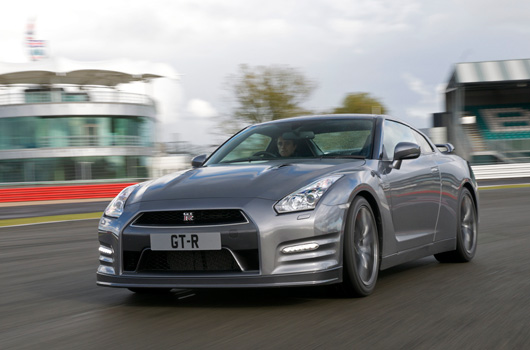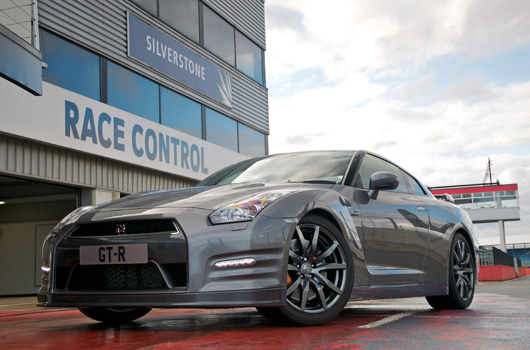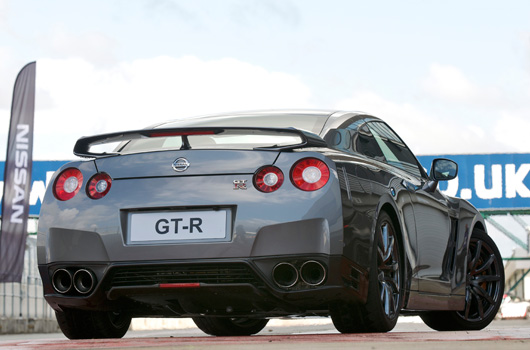It looks just like the old one, but Nissan is adamant they have made changes to their flagship GT-R model. First, the big news, a reversing camera is now standard!
Of more merit is a 20PS power increase, taking the peak figure up to 550PS (404kW). Twenty seems to be the magic number, too, as torque has also been given a 20Nm boost, now topping out at 632Nm. Coupled with revisions to intake efficiency, exhaust valve cooling and a few other tweaks Nissan reckon low-mid range engine response has been significantly improved.
The transmission is smoother thanks to some minor mechanical tweaks and the use of a specially developed competition-based oil. Of particular note to Australian buyers is word that RHD models will have a tailored suspension setup. As well as the driver the propeller shaft for the front wheels is on the right side of the car. Nissan compensates for this by having different spring rates for the left and right side as well as changing the installation method for the rear suspension arms.
So, do these changes make a jot of difference? According to Car magazine, they do: “The engine’s response is cleaner, there’s a new appetite to the way it revs to the limiter, the chassis is more fluid and the four-wheel drive system works with more subtlety and there’s less pitch under braking.” Job well done, it seems.
As with previous model year updates Nissan Australia is planning for a March release. Manufacturer’s list pricing has been confirmed at $170,800 retail price. Although, the MY12 GT-R will go on sale in Japan later this month. More detail from Nissan is available after the break.
UPDATE: Short promo video added below.
From Nissan Australia:
Nissan Releases the 2012 Model Year Nissan GT-R
Nissan Motor Co., Ltd. last night announced the launch of the 2012 model year Nissan GT-R. The new model goes on sale in Australia next March priced at $170,800.
At a glance
- More power (404kW), improved economy and lower emissions
- Unique asymmetric suspension settings on RHD cars
- Enhanced transmission shift feel
- Special race tuned oils used in differential
- Body strengthened for even greater handling finesse
- New Bose® Precision Sound System woofers
- Rear view camera now standard
Significant improvements to the engine, chassis and transmission accentuate the pure performance potential of the GT-R are the key changes to Nissan’s flagship model for the 2012 model year.
When it was launched, the iconic GT-R created a new type of super car. Performance and handling were exceptional, of course, but more importantly the car’s potential was accessible to all drivers under all conditions. It was greeted with universal praise but Nissan’s policy of constant development means the GT-R continues to evolve.
The latest version is the most efficient yet. It offers even greater performance but this is allied to improved economy and lower emissions to provide further excitement to drivers and passengers.
As well as more power, the 2012 GT-R has a newly developed asymmetric suspension which compensates for greater weight on the driver’s side in RHD models, enhanced transmission ‘feel’ and a stronger body for extra rigidity and ever better handling.
2012 MY Nissan GT-R Overview
1. Mechanical Features
Engine
By improving the GT-R’s engine efficiency, its fuel economy has been decreased from 12L. to 11.8L/100 Kms, while engine output rises significantly from 390kW to 404kW from /6,400rpm with maximum torque of from 612 to 632Nm from 3,200 to 5,800 rpm.
Engine response and torque at mid- and low-speeds, and power at high revolutions, has been significantly improved, mainly due to:
- Improved intake efficiency
- Better air flow resistance, which has been reduced by the addition of an intake manifold fitted to the head of each unit and the use of resin in the enlarged air intake duct for the intercooler.
- Improved exhaust emissions efficiency and enhanced control.
- Reduced air flow resistance thanks to a more compact under floor catalyzer which improves emissions efficiency and reduces weight.
- Improved exhaust valve cooling performance by the adoption of a newly-designed metallic sodium-filled valve. At the same time, valve control timing, the air mixture ratio and ignition timing have been improved.
Transmission
Shift feels and quietness has been refined thanks to a strengthened design of the shift fork arm and a firmer fixing bearing for the flywheel housing. A special differential oil R35 COMPETITION Type 2189E (75W140), which was developed for competition is now used in every version of GT-R.
Body
As well as greater power and torque, the reinforcing of certain areas around the rear part of the engine compartment and dash panel deliver more responsive handling while a greater sense of the vehicle’s grip on the road is transmitted to the driver.
At the same time, more precise production methods, accompanied by advancements made in the vehicle body, have improved the inter-vehicle detection capability. This was achieved by changes in the positioning of the sensor and more rigid, highly-damped vehicle body, and by adding a more accurate acceleration sensor in areas with higher sensitivity in the vibration testing of each vehicle body.
Suspension and brakes
Accounting for the added weight of the driver in a right-hand drive vehicle coupled to the fact that the propeller shaft for front wheels is located on the right side of the vehicle; the GT-R’s suspension in RHD versions has been set asymmetrically. For the front suspension, there’s a harder spring rate on the left side while at the rear the suspension arm has been installed upwards on the left side and downwards on the right. This means an imbalanced wheel load when the car is stationary, but which is equalized during driving, providing improved responsiveness, smoothness and steering feel, as well as enhanced cornering stability and riding comfort (for RHD only).
2. Interior
The quality feel of the instruments placed in front of the driver have been enhanced by the addition of blue lighting inside the tachometer ring to match the shift position indicator light giving a more sophisticated atmosphere in the cockpit.
Rear View Camera device will be standard on all models.
The Bose® sound system woofers, have been changed to Bose® Precision Sound System woofers that were developed for the EGOIST grade to further enhance sound quality.
With the latest 2012MY version, the legend that is the Nissan GT-R continues to evolve.
From Nissan UK:
Nissan reveals the 2012 model year GT-R
Nissan Motor Co., Ltd. today (7 November 2011) announced the launch of the 2012 model year Nissan GT-R. The new model goes on sale 24 November in Japan and arrives in European showrooms from early 2012.
At a glance
- More power (550PS), improved economy and lower emissions
- Unique asymmetric suspension settings on RHD cars
- Rear view camera now standard
- New track focused version to come to the UK
Significant improvements to the engine, chassis and transmission which accentuates the pure performance potential of the GT-R are the key changes to Nissan’s flagship model for the 2012 model year.
This latest version, which goes on sale from early December for the UK with deliveries expected in early 2012, is the most efficient yet. It offers even greater performance but this is allied to improved economy and lower emissions to provide further excitement to drivers and passengers.
As well as more power, the 2012 MY GT-R has a newly developed asymmetric suspension which compensates for greater weight on the driver’s side in RHD models, enhanced transmission ‘feel’ and a stronger body for extra rigidity and ever better handling.
2012MY Nissan GT-R Overview
1. Mechanical Features
Engine
By improving the GT-R’s engine efficiency, its fuel economy has been improved to 24mpg (from 23.5mpg), while engineoutput rises significantly to 550PS (+20PS) at 6,400rpm with maximum torque of 632Nm (+20Nm) from 3,200 to 5,800 rpm.
Engine response and torque at mid and low-speeds, and power at high revolutions, has been significantly improved, mainly due to:
- Improved intake efficiency
- Better air flow resistance, which has been reduced by the addition of an intake manifold fitted to the head of each unit and the use of resin in the enlarged air intake duct for the intercooler.
- Improved exhaust emissions efficiency and enhanced control.
- Reduced air flow resistance thanks to a more compact under floor catalyser which improves emissions efficiency and reduces weight.
- Improved exhaust valve cooling performance by the adoption of a newly-designed metallic sodium-filled valve. At the same time, valve control timing, the air mixture ratio and ignition timing have been improved.
Transmission
Shift feels and quietness has been refined thanks to a strengthened design of the shift fork arm and a firmer fixing bearing for the flywheel housing. A special differential oil R35 COMPETITION Type 2189E (75W140), which was developed for competition is now used in every version of GT-R.
Body
As well as greater power and torque, the reinforcing of certain areas around the rear part of the engine compartment and dash panel deliver more responsive handling while a greater sense of the vehicle’s grip on the road is transmitted to the driver.
At the same time, more precise production methods, accompanied by advancements made in the vehicle body, have improved the inter-vehicle detection capability. This was achieved by changes in the positioning of the sensor and more rigid, highly-damped vehicle body, and by adding a more accurate acceleration sensor in areas with higher sensitivity in the vibration testing of each vehicle body.
Suspension and brakes
Accounting for the added weight of the driver in a right-hand drive vehicle coupled to the fact that the propeller shaft for front wheels is located on the right side of the vehicle; the GT-R’s suspension in RHD versions has been set asymmetrically. For the front suspension, there’s a harder spring rate on the left side while at the rear the suspension arm has been installed upwards on the left side and downwards on the right. This means an imbalanced wheel load when the car is stationary, but which is equalised during driving, providing improved responsiveness, smoothness and steering feel, as well as enhanced cornering stability and riding comfort (for RHD only).
2. Interior
The quality feel of the instruments placed in front of the driver have been enhanced by the addition of blue lighting inside the tachometer ring to match the shift position indicator light giving a more sophisticated atmosphere in the cockpit.
Rear View Camera device will be standard on all models.
The Bose® sound system woofers, have been changed to Bose® Precision Sound System woofers that were developed for the EGOIST grade to further enhance sound quality.
3. TRACK FOCUSED VERSION (developed only in right hand drive form for – Japan and UK)
A new version within the GT-R line up is currently being planned for the UK, designed for customers who want to enjoy a more track biased driving experience in their Nissan GT-R at a competitive price.
Further details of this version and pricing of the MY2012 GT-R is expected in early December.
With the latest 2012MY version, the legend that is the Nissan GT-R continues to evolve.



10 replies on “Nissan GT-R – MY12 specs released”
[…] month Nissan was at the Nürburgring finalising preparations for the launch of the 2012MY GT-R. Apparently this video was filmed at the same time and shows ‘Godzilla’ has reduced its […]
[…] Harris was at the launch of the 2012 Nissan GT-R held at Silverstone recently. A known lover of Porsches and part-time factory racer, what will he […]
[…] it’s as sharp as a knife. Like Rafa Nadal winning an unwinnable point, how do they do it? In MY12 spec the GT-R can sprint to 100km/h in under three seconds. Time after time, after […]
[…] his latest Drive clip Chris Harris has put a 2012 BMW M5 up against a 2012 Nissan GT-R? That doesn’t make any sense. Well, according to Google and YouTube it does. From the video […]
[…] Australia advises the MY12 spec GT-R, announced last November, officially goes on sale this week. You’ll need $170,800 if you want to get yourself the […]
[…] Tiff Needell moonlights for Evo in his latest track comparison. His weapons of choice are the MY12 Nissan GT-R and the 991 Porsche 911 Carrera S. Nissan v Porsche, it’s the Ford v Holden of the supercar […]
[…] might think a video comparing a 2013 Nissan GT-R Black Edition with a 997 Porsche 911 Turbo S would be pretty entertaining. Especially when you […]
[…] original concept was based on the MY10 GT-R, but the real-deal Juke-R will be based on the more powerful MY12 spec. Nissan hasn’t put a cap on the number of Juke-Rs they will make, saying instead there will […]
[…] ever thought of comparing the limited-edition Audi A1 quattro (188kW/350Nm) with the all-conquering Nissan GT-R (404kW/632Nm)? No, neither had […]
[…] highly desirable Audi R8 V10 Plus, the equally wantable 997 Porsche 911 Turbo S and giant killing Nissan GT-R that’s been warmed over by […]